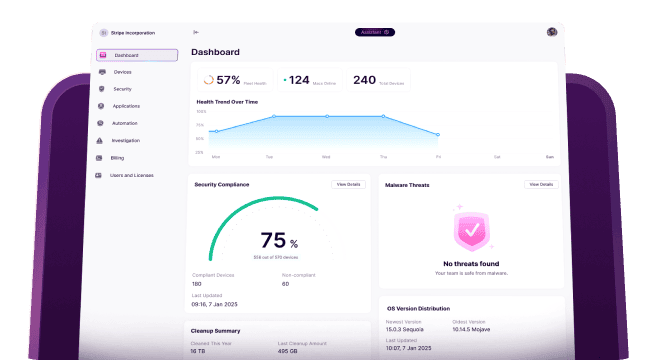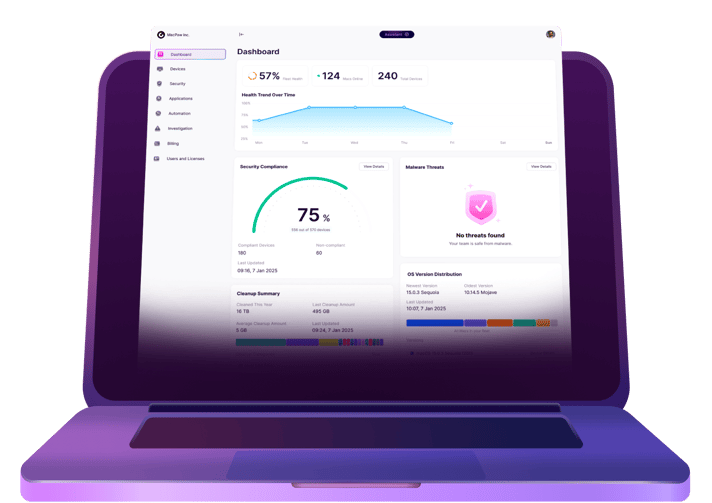Sometimes a little separation can be a good thing. Ask any network admin, and they’d probably agree with you, especially when it comes to network design or, more specifically, network segmentation.
But what is network segmentation exactly, and why should you care about it?
Luckily, you’ve landed in the right spot. In this article, I will explain the concept of network segmentation and will show you why it’s important and how it can help keep your network secure. So, keep reading!
What is network segmentation?
Simply put, network segmentation is the process of dividing up a large network into smaller subnetworks, or subnets. This way, it gives your IT team more control and better security of your company’s internal network.
Think of it like dividing up a big building into smaller rooms. Each room can be secured by a unique lock on the door, or it can be left wide open for everyone in the house to have access to it. Similar to how a bedroom is more private than, say, your kitchen.
That’s exactly how subnets work as well. By dividing your network, you’ll have better control and be able to monitor the flow of data. Which will help you ensure everything is working properly and spot any unusual activity.
Why is network segmentation important?
These days, cyber threats are becoming more and more sophisticated. But with the help of proper network segmentation, it would require multiple attacks with multiple points of entry to bring down your company’s entire network.
When you have smaller subnets in place, you can reduce your company’s exposure to cyber threats. So, if you do have a vulnerability, it’s on a much smaller portion of your infrastructure. It limits the total damage the threat can cause and helps you quickly isolate it from spreading.
Top network segmentation benefits
Keeping your company’s network secure should be your IT team’s number one priority. Network segmentation is a strategy that has many benefits. Things like improved security and optimized network performance.
Now, let’s dive into some of the specific benefits of using network segmentation in your organization.
Enhanced security
One of the biggest benefits of segmenting your network is improved security. When you use smaller subnets, it’s harder for hackers to get access to all of your company’s data.
Adding these extra layers of security makes it even more difficult. But doing this requires a hacker to breach a subnet with access to your sensitive data. That way, even if your company is breached, a hacker may only have access to a printer or guest subnet. Considerably reducing the risk of a serious leak.
Better performance
Segmentation can also help improve your network’s performance. By using smaller subnets, each can be optimized for specific tasks and applications. Which can also help reduce downtime when there are issues. For example, you could create a subnet specifically for video conferencing, allocating more bandwidth for video than other subnets in the office.
Improved management
Many network admins like using segmentation because of how much easier it can make managing and monitoring the network. That’s because each subnet can be individually managed, removing some of the complexities that come with keeping a large network locked down and secure.
Segmenting a network can help simplify troubleshooting as well. If only multiple users are having issues on the same subnet, then you can quickly identify where the problem is occurring. Allowing you to respond and fix the issue quicker.
Compliance with regulations
Certain industries require different regulations for security’s sake. Network segmentation is a fairly standard requirement. A great example of this is the healthcare industry. Many organizations and offices have to follow HIPAA regulations to keep patient information safe. Network segmentation can help ensure that even if there’s a breach, sensitive patient data doesn’t end up in the wrong hands.
Increased flexibility
Finally, network segmentation can make your business more agile. Network teams are able to create new subnets if the needs of their company change. All without having to reconfigure the entire network. This allows companies to adapt as their business grows and evolves over time.
Common network segmentation examples
Network segmentation is a critical part of your business’s overall security. However, it can be hard to fully grasp it without seeing it in action. Let’s look at a few real-world examples so that you can get a better understanding of how it works and why it’s important.

Employee segmentation
You could look at segmenting your network based on your employees. Depending on their roles and responsibilities, you can group together the employees and teams that interface the most with each other. Keeping each network on a more need-to-know basis.
A good example would be to keep the HR department removed from the rest of your organization. Since they typically have to receive and store sensitive employee information. So, to ensure someone in marketing can just people up anyone’s employee file, you’d keep them on separate subnets.
Guest network
If you have partners and consultants coming into your office on a regular basis, you might not want them to have access to all of your internal files. Creating a subnet specifically for guests can keep your company’s data secure. But also, if a guest brings a device with a virus or malware into your office, this guest subnet can prevent that infection from spreading.
Internet of Things (IoT) Devices
These days, there are so many devices in an office that aren’t computers. Every employee brings in a phone, some have wearable devices like smart watches, and others even bring in personal tablets and e-readers. Having a separate subnet for the IoT devices that are in your office can also help lock down your environment. While also saving the bandwidth on your work subnets for important business to get done.
Cloud services
You can also design your network to include smaller segments specifically for cloud services. But, because many of these services update in the background, they can be a drain on your network’s bandwidth. So, having a separate subnet just for cloud services can also optimize your internal network for business-critical work.
VoIP telephony
A business can create a separate segment for Voice over IP (VoIP) telephony, guaranteeing that voice and data traffic are kept separate and voice traffic has dedicated network resources.
The number of ways network segmentation can help improve your company’s infrastructure really depend on how you implement it. The use-cases you just read about are only a few of the more common examples.
As you’re segmenting your network and putting policies into place, you should make sure every decision you make helps your network become more secure, optimized, or manageable.
Best practices for how to segment a network
Protecting your company’s network and sensitive data requires proper network segmentation. But when you’re just starting to design the network, all of the options can be overwhelming. How do you determine what the best approach for your company will be?
In this section, I want to dive into the best practices for effectively segmenting your network. That way, you can ensure maximum security and peace of mind, whether you’re just starting to think about network segmentation or looking to improve your existing design.
The following tips and guidelines will help you as you create your first subnets — making it an easier process overall. That way, you can segment your network faster while also making it more secure at the same time.
Define segmentation goals
The first step to segmenting your network is figuring out what your goals are. You can start by identifying which parts of the network need to be isolated. Perhaps, more importantly, it is also answering why they need to be isolated. Doing this will help you ensure everything you’re doing is in line with your business’s overall goals.
Use VLANs and firewalls
When it comes time to set up your subnets, you’ll want to use VLANs, or Virtual Local Area Networks, to help. Then, you can use firewalls to keep the subnets secure, controlling who has access to each one.
Monitor network traffic
Take advantage of any tools that can help you monitor your network traffic. Tools like these make it easier to spot suspicious activity — both inbound and outbound activity.
If you see someone accessing data that shouldn’t be, that’s an immediate red flag that you can stop before something serious is leaked.
Implement access controls
Access controls are used to make sure that only the intended users can access sensitive data. To do this, you’ll need to set up various control policies for each subnet.
Regularly review and update segmentation
Regularly reviewing and auditing your subnets is a critical last step. As time goes on, you will make changes to your segments. But setting aside specific time to make sure everything is configured properly and up to date is an essential part of keeping your network optimized for security and performance.
By segmenting the network, businesses can achieve these benefits and meet regulatory requirements. Network segmentation is an essential tool for any business. Rolling it out should be a priority for organizations of all sizes.







